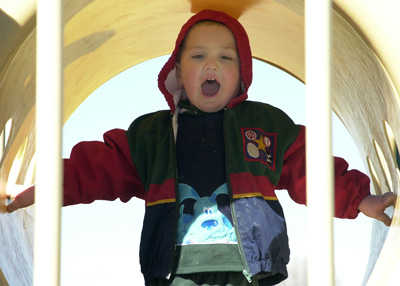By Staff Sgt. C. Todd Lopez
WASHINGTON (March 17, 2003) -- A survey designed to gauge the Air Force's success in building communities is set for distribution in early April.
The 2003 Community Assessment Survey will be sent out servicewide, said the Air Force's director of family advocacy research and the project officer for the survey. He added that the Air Force will use the survey results to learn how to help its people better.

"We want to find out what people really need and what would help them make their communities and their lives in the Air Force better," said Maj. James D. Whitworth. "The assessment goes out to active-duty members and to their spouses as well as some Reserve members and spouses."
Variations of the assessment have been conducted once every 24 to 30 months since 1993. This year, the total number of people who will be asked to take the assessment is around 1,800 at each of 85 Air Force installations worldwide. Those taking the survey will be randomly chosen, and the survey is completely anonymous.
Questions on the assessment, Whitworth said, cover basic needs by asking about "key areas necessary for building strong communities."
"These areas include a person's sense of community, family adaptation, safety, spiritual well-being, health and well-being, economic well-being and preparedness," he said.
Questions on the assessment ask about the availability of community resources and about how connected, or a part of the community, people feel they are. For example, one question asks if people feel there are enough places on their installation to spend time with co-workers after duty hours. Another asks about relationships with supervisors.
Assessment results, Whitworth said, will not fall on deaf ears. In fact, bases have used past results to make changes in the services they provide on base and even in the services and options available to people off base.
"There was one (installation) where they identified that spouse employment was a real problem," Whitworth said. "The spouses had indicated on the community assessment that there were just no jobs, and so the base leadership was able to target that issue. The installation was able to get some businesses to relocate to (its) installation and as a result there was a 15 percent increase in spouse employment from one assessment to the next."
Whitworth said the key to the success of the assessments is that Air Force leaders will be better able to help their people help themselves.
"We've found the most powerful way to help people is to help their informal networks -- to help people to establish more and better friendships, to help them to get to know their neighbors and get involved in their community," Whitworth said.
For example, he said, an Air Force community in Germany used the survey to help alleviate the isolation of younger, enlisted families who lived in apartment-style homes.
"What the team did was to set up picnics and other activities in the stairways and in the hallways of those apartment buildings," he said. "That solution helped create more friendships among the people who lived there."
Active-duty people will be notified by e-mail, while spouses will be notified by postal mail. Airmen can complete the assessment on a designated Web site, while spouses have the option of completing it on paper. The effectiveness of the assessment depends totally on participants' willingness to accurately complete it, Whitworth said. It is designed to take less than 20 minutes to complete.
"Our goal is to make improvements in building stronger communities without guessing, so we need to know people's thoughts and needs," he said. "If people don't tell us what they need or identify areas where we can improve or what the problems are, it will be much harder to reach our goal. We urge all active duty and family members who receive these assessments to take the time to complete the assessment and to help us strengthen our Air Force communities. This assessment is their chance to do that."